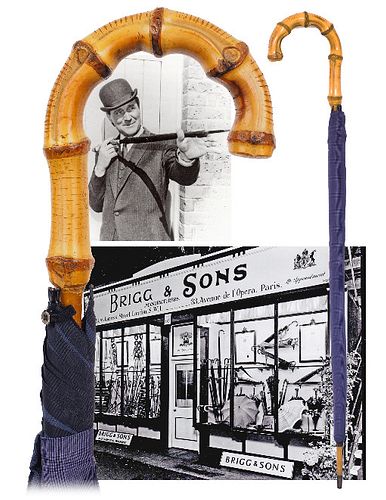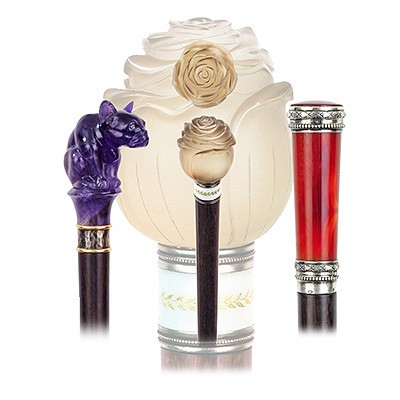Thomas Brigg & Sons Whangee Umbrella
Lot 112
About Seller
Kimball Sterling
125 West Market Street
Johnson City, TN 37604
United States
Family-owned and family-run Johnson City Tennessee auction business for 25 years. Selling antiques and collectables for 38 years. Kimball M. Sterling, Inc. was founded and is owned by Kimball and Victoria Sterling, time and again, they have laid solid claim to world-wide attention and renown with an...Read more
Categories
Estimate:
$100 - $200
Absentee vs Live bid
Two ways to bid:
- Leave a max absentee bid and the platform will bid on your behalf up to your maximum bid during the live auction.
- Bid live during the auction and your bids will be submitted real-time to the auctioneer.
Bid Increments
| Price | Bid Increment |
|---|---|
| $0 | $10 |
| $100 | $25 |
| $500 | $50 |
| $1,000 | $100 |
About Auction
By Kimball Sterling
Dec 3, 2022
Set Reminder
2022-12-03 13:00:00
2022-12-03 13:00:00
America/New_York
Bidsquare
Bidsquare : The 2022 Cane Masterpiece Auction
https://www.bidsquare.com/auctions/kimball-sterling/the-2022-cane-masterpiece-auction-11295
The European Masterpiece Cane Collection Kimball Sterling kimballsterling@earthlink.net
The European Masterpiece Cane Collection Kimball Sterling kimballsterling@earthlink.net
- Lot Description
-Ca. 1960 -Classic English umbrella with a sizeable whangee crook handle, a wood pole shaft, metal ferrule, U-shaped steel ribs and stretchers and a blackened brass, sliding runner. The probably refurbished canopy of the umbrella is made up of eight grayish-blue squared pattern silk with matching tie wrap and black steel popper and turned black steel rib tips. -All Brigg umbrellas were things of beauty, but this one is sleeker and more covetable than all the others that had gone before it. Any stylish gentleman was bound to want one, even if he had several Briggs already. -Anyhow, best British quality and repeatedly winners of coveted Design Council Awards, this umbrella obeys to long gone rigorous standards of production and also proves to that it was made to last. -H. 5 ¾” x 7”, O.L. 36” -$100-$200 -Published in the book “In Good Hands, 250 years of craftsmanship at, Swaine Adeny Brigg” by Katherine Prior, pages 120-121, this Brigg umbrella related story is worth two minutes reading. -“One gentleman’s umbrella in particular achieved world fame - this was Neville Chamberlain’s black silk which he took with him to talks with Adolf Hitler at Munich in September 1938. The world, holding its breath in hope of peace, looked on in amazement as photographs emerged of Chamberlain’s immaculately furled umbrella claiming a starring role in the proceedings. A few months later, in January 1939, the same umbrella twirled its way to Rome, when Chamberlain paid a visit to Benito Mussolini. Newspapers devoted column inches to this unlikely symbol of hope, with one or two of Brigg’s salesmen providing discreet insights into the great man’s brolly behaviour. Every few years, they reported, Chamberlain personally brought his umbrella into the St James’s shop to be recovered. While it was being examined, he would while away the minutes admiring and fondling the more flamboyant styles on display, but he was never tempted to buy another, and always ordered simply that his old one be recovered. According to Viscountess Elibank, his wife had given it to him in 1899 and he refused therefore to countenance its replacement. It was a heavy black silk affair, with a Malacca cane handle, seven-eighths of an inch thick, spliced onto a Tonkin cane shaft, with a gilt collar. One of Brigg’s insiders reported that it had originally cost £2 17s 6d, but that if the collar had been of solid gold the price would have been six guineas. It was smart but not showy. `It’s what one might call a Rolls-Royce of an umbrella,’ the insider added. ‘Natty but quiet; solid, but lighter, the sort of umbrella which becomes part of a man, if I may say so.’ The repair men recovered it each time, but they could not help but notice that it had not been opened since they had last ironed its hand-stitched gores into pristine pleats. Chamberlain had most recently brought it in just before he flew to Munich. This press reportage seemed to confirm Chamberlain’s reputation as a sober and restrained politician, not given to rash decisions. In the United States the fascination with Chamberlain’s prop prompted articles on the style and deportment of a true gentleman and kicked off a local revival in umbrellas and parasols. In July 1939 Life magazine devoted an article to the ‘umbrella of appeasement’, which was not yet a derogatory term for most people. For a few short months, umbrellas were no longer associated with soggy gloom, but were wielded in a spirit of hope and optimism. For his part, Hitler, who had resented being forced into a diplomatic conference of `equals’ at Munich, could barely contain his scorn for `umbrella politicians’. At the time all this fuss must have seemed like magnificent publicity for Brigg. Indeed, the shop men could not have spoken to the press without the blessing of Brigg’s management. But ultimately, of course, it was an ironic prelude to the ending of the company’s independence. A few months later, the war that Chamberlain had tried to avert erupted, and soon afterwards Brigg lost their Paris showroom. The merger of Thomas Brigg & Sons with Swaine & Adeney followed in February 1943. When the war was over, a new era of economic austerity and political levelling ensured that the art of making and selling quality umbrellas would never again be quite the same.”
- Shipping Info
-
Each auction has different shipping terms but the buyer always pays. Shipping will be delayed in this auction due to delay of customs.Canes:After payment has been received we will contact you.
- Buyer's Premium
-



 EUR
EUR CAD
CAD AUD
AUD GBP
GBP MXN
MXN HKD
HKD CNY
CNY MYR
MYR SEK
SEK SGD
SGD CHF
CHF THB
THB


















